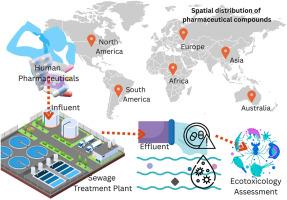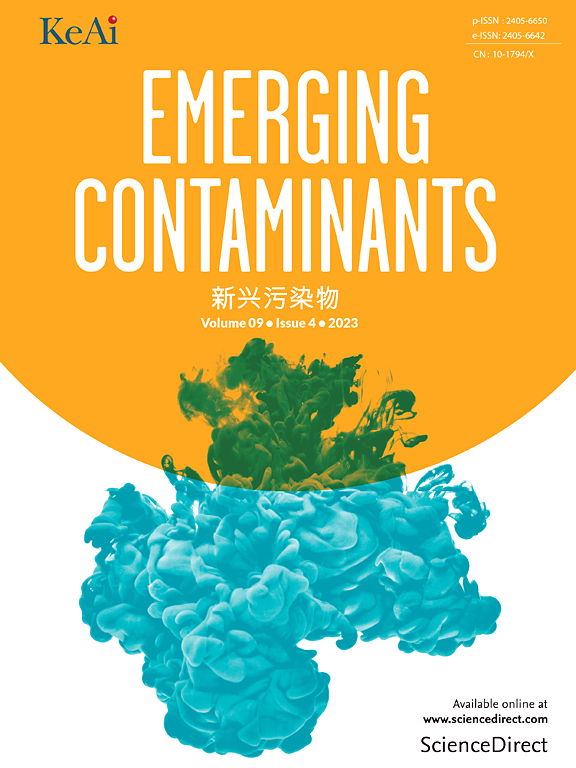Global pharmaceutical pollution in waterways: Insights from sewage treatment point sources
IF 6.9
2区 环境科学与生态学
Q1 ENVIRONMENTAL SCIENCES
引用次数: 0
Abstract
The global presence of pharmaceutical residues in sewage is a growing environmental concern, driven by human excretion, improper disposal, and industrial waste streams. This study synthesized data from meticulously selected 101 peer-reviewed publications to evaluate the occurrence of 20 pharmaceuticals in sewage influent and effluent as a primary point source of pollutants across diverse geographical regions, analyzed based on Asia, America, Europe, Africa and Australia. The highest cumulative concentrations of pharmaceuticals, particularly analgesics/anti-inflammatory drugs, were observed in North and South America, while most of the publications were dominantly published under the European region. Diclofenac, ibuprofen, sulfamethoxazole, and ciprofloxacin were the most frequently detected compounds and were found at high concentrations, exceeding 100,000 ng/L in the influent of some STPs. Ibuprofen and naproxen demonstrated high removal efficiencies, consistently exceeding 80 %, with no instances of negative removal observed. Atenolol, simvastatin, and valsartan exhibited substantial removal, though some STPs showed increased effluent concentrations. Contradictorily, diazepam, carbamazepine, azithromycin, and clindamycin demonstrated persistence through the conventional treatment processes, as evidently shown by the predominantly negative removal percentages. The occurrence of pharmaceuticals in sewage treatment plants (STPs) represents a significant global risk to both ecosystems and human health. Ecotoxicological risk assessments, based on hazard quotients (HQs) derived from the maximum measured concentrations, revealed heightened vulnerability among primary producers and consumers in aquatic environments, with higher trophic levels facing risks from bio-accumulative compounds. This pervasive micropollutant contamination emphasizes the critical need for improved wastewater treatment technologies, rigorous regulatory frameworks, and sustainable pharmaceutical disposal practices to minimize ecological impacts.

全球水道中的药物污染:来自污水处理点源的见解
由于人类排泄、不当处理和工业废物流,全球污水中存在的药物残留物日益成为环境问题。本研究综合了精心挑选的101份同行评审出版物的数据,以评估20种药物在不同地理区域的污水和污水中作为污染物的主要点源的发生率,并基于亚洲、美洲、欧洲、非洲和澳大利亚进行了分析。药物,特别是镇痛药/消炎药的累积浓度最高的是北美洲和南美洲,而大多数出版物主要是在欧洲区域发表的。双氯芬酸、布洛芬、磺胺甲异唑和环丙沙星是最常检测到的化合物,在一些stp的进水中发现的浓度很高,超过100,000 ng/L。布洛芬和萘普生表现出很高的去除效率,始终超过80%,没有观察到负去除的情况。阿替洛尔、辛伐他汀和缬沙坦表现出大量的去除,尽管一些stp显示出污水浓度增加。相反,地西泮、卡马西平、阿奇霉素和克林霉素在常规治疗过程中表现出持久性,这明显表明了主要的阴性去除率。污水处理厂(STPs)中药物的出现对生态系统和人类健康构成了重大的全球风险。基于最大测量浓度得出的危害商(HQs)的生态毒理学风险评估显示,水生环境中初级生产者和消费者的脆弱性较高,营养水平较高的人面临生物蓄积性化合物的风险。这种普遍存在的微污染物污染强调了改善废水处理技术、严格的监管框架和可持续的药物处理实践以尽量减少生态影响的迫切需要。
本文章由计算机程序翻译,如有差异,请以英文原文为准。
求助全文
约1分钟内获得全文
求助全文
来源期刊

Emerging Contaminants
Medicine-Public Health, Environmental and Occupational Health
CiteScore
10.00
自引率
6.70%
发文量
35
审稿时长
44 days
期刊介绍:
Emerging Contaminants is an outlet for world-leading research addressing problems associated with environmental contamination caused by emerging contaminants and their solutions. Emerging contaminants are defined as chemicals that are not currently (or have been only recently) regulated and about which there exist concerns regarding their impact on human or ecological health. Examples of emerging contaminants include disinfection by-products, pharmaceutical and personal care products, persistent organic chemicals, and mercury etc. as well as their degradation products. We encourage papers addressing science that facilitates greater understanding of the nature, extent, and impacts of the presence of emerging contaminants in the environment; technology that exploits original principles to reduce and control their environmental presence; as well as the development, implementation and efficacy of national and international policies to protect human health and the environment from emerging contaminants.
 求助内容:
求助内容: 应助结果提醒方式:
应助结果提醒方式:


